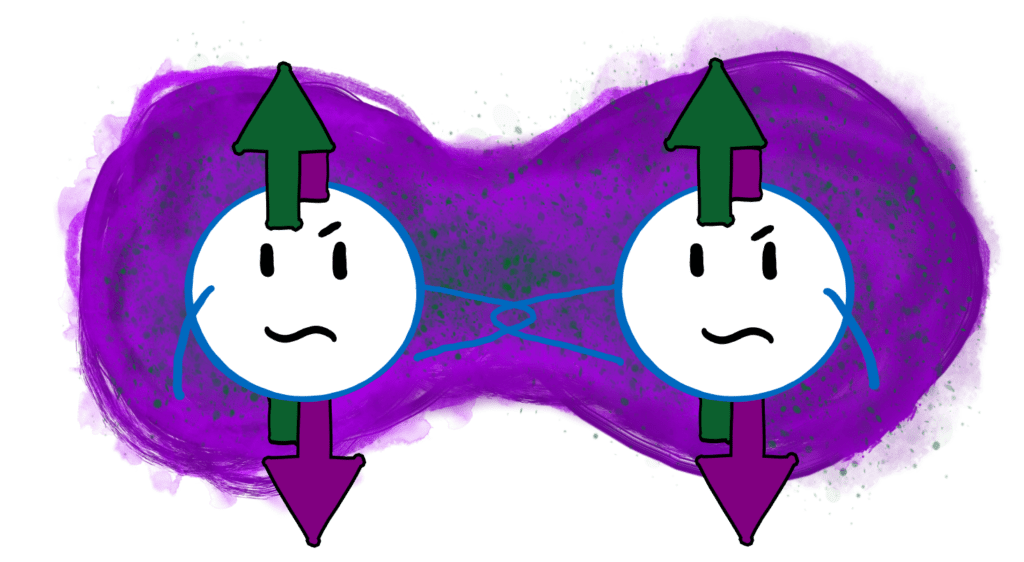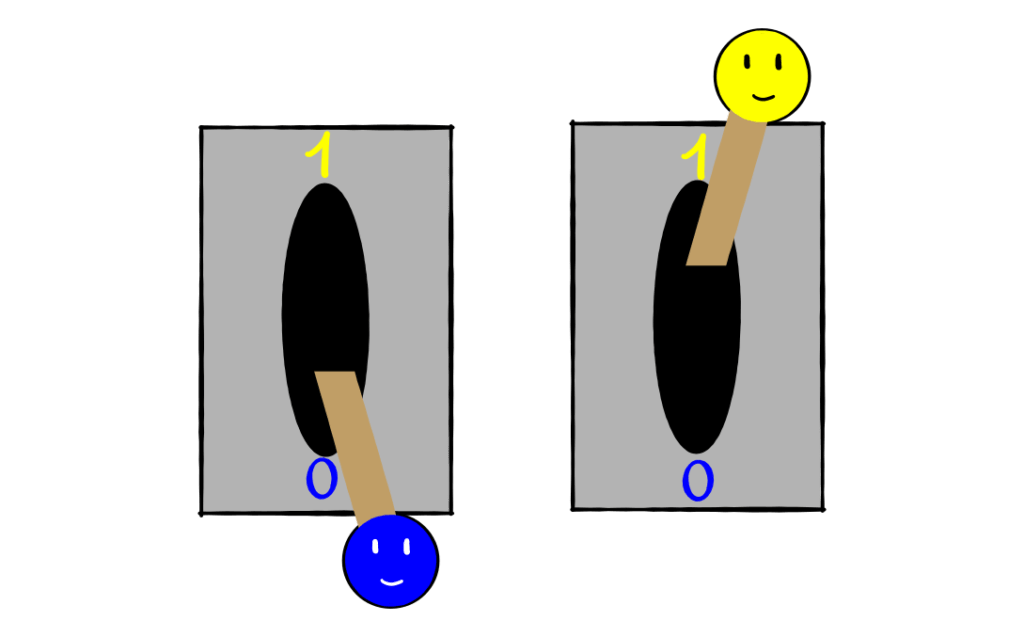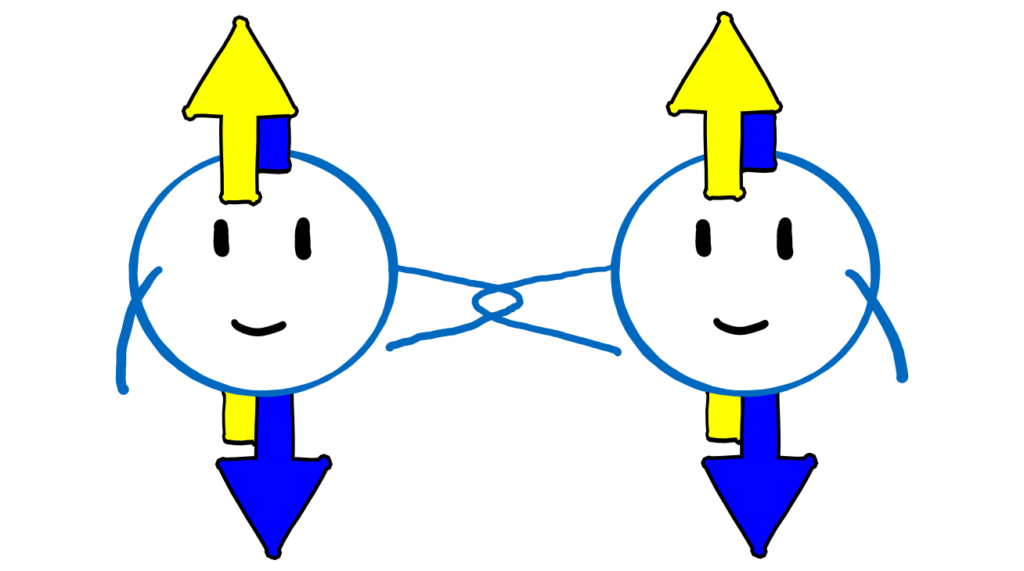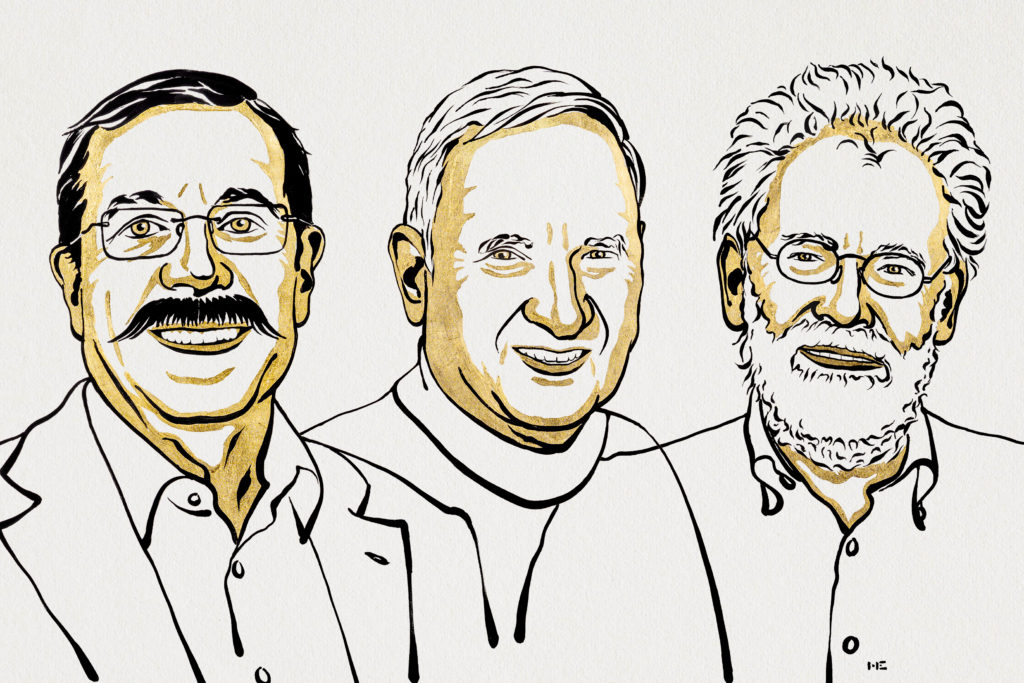As Andy Williams sang: It’s the most wonderful time of the year! No, not Christmas – the Nobel Prizes were awarded! This year, the Nobel Prize Committee had a special gift for us: A Nobel Prize for Quantum Physics! Exactly 10 years after the last big Nobel Prize was awarded to the quantum physicists Serge Haroche and David Wineland. No question that we have to take a closer look.
We have a lot ahead of us today: spooky remote action, dice-playing gods, farewell to reality. We explore what it is about quantum systems being able to be “0 and 1 at the same time” – because this is only a weak attempt to circumscribe the inexplicable.
The 2022 Nobel Prize in Physics went to Alain Aspect, John F. Clauser, and Anton Zeilinger “for experiments with entangled photons that demonstrated the violation of Bell’s inequalities and paved the way for quantum information science.” It’s all about entanglement, violated inequalities, and quantum technology. Get ready, grab some tea and a Cheshire Cat – it’s going to be exciting!
Entanglement: two parts from a whole
Entanglement is arguably the effect that has made quantum physics as a whole the most debated and questioned theory. In 1935, Erwin Schrödinger stated that two quantum mechanical systems that had been in contact with each other for a while could no longer be described as two independent systems. Rather, they can only be described together, as two parts of a whole. He called this the characteristic property of quantum mechanics.
I’ve written about entanglement on my blog before, so here’s a little recommended reading for newcomers (welcome!), the forgetful, or the particularly interested:
- Schrödinger’s Christmas present: A Christmas explanation of Schrödinger’s cat. Actually, Schrödinger wanted to show with his thought experiment how absurd quantum physics is, after all, there are no half-dead cats. It can be solved with the help of decoherence.
- FAQ: Quantum computing – From qubit to quantum computer: an explanation of how entanglement helps build quantum computers. And why it’s not so easy. If you’ve ever heard the word quantum parallelism but didn’t understand it, this article is for you!
- Superluminal elf radio: A misconception is that information can be transmitted faster than the speed of light with the help of entanglement. Even Einstein was bothered by this. But why this is not true, and how it could work instead, I explain here.
- Schrödinger’s tardigrade: At the end of 2021, a tardigrade went viral that was supposed to have been entangled with a qubit. I took a closer look at the paper – and had a great time.
Entanglement is often described as perfect correlation. In my FAQ: Quantum Computing, I talk about all-best-friend qubits: If one qubit is happy, so is the other. When the other is mad, so is the other. The state of one qubit cannot be described without the state of the other: they are perfectly correlated.

But that is only part of the truth. Quantum systems are actually even more powerful – and more complicated. I plead guilty that in all my previous articles about entanglement, I have omitted, simply oversimplified, an important point which is crucial for the explanation of Bell’s inequality: The choice of the basis.
Life is a choice of basis
Let’s go to bits and qubits as an example. When I say bit, I actually just mean a little switch that points either up or down. Let’s assume my switch is colored: up stands for yellow, down for blue.

Qubits are switches made of quantum systems and these can also, like the bits, point up or down: Yellow or Blue. But qubits can do more: they can move on the whole colour circle. They can point to the left and are green, or to the right and then they are red. At 8 o’clock they are turquoise, at 1 o’clock orange, at 4:21 piggy pink.

A bit cannot do that. If I want a red-green switch, I have to build a new one. A single qubit can represent all these switch options. Which colour combination I query is a question of the basis: Whether I use the yellow-blue base or the red-green one is up to me.
Expert info: There is still a small simplification in here. A qubit is actually a sphere and not a circle. However, we allow ourselves this simplification at this point, because a circle is sufficient to understand Bell’s inequalities.
EPR thought experiment
Let us now assume that we have this entangled state:

Here, either both qubits are yellow or both qubits are blue. So we are in the yellow-blue base. We now put both qubits in a box each and give them to two people, let’s call them Alice and Bob. Now, if Alice opens her box and finds a yellow qubit, we know IMMEDIATELY that Bob’s qubit is also yellow. If Alice’s qubit is blue, then Bob’s qubit is also blue.
Spooky action at a distance
Let’s pause for a moment. This is strange. What if Alice is in Berlin, but Bob is on the moon? Nevertheless, Bob’s qubit immediately turns yellow as soon as Alice sees that her qubit is yellow.
Doesn’t that contradict the theory of special relativity? Namely, that nothing could be faster than light? “Immediately” is faster than light! Einstein didn’t like that at all, and therefore called the immediate transfer of the measurement result by entanglement “spooky action at a distance”.
Fine difference: He was less bothered by the entanglement itself, but more by the consequences of it. Namely, Bob’s qubit is affected by Alice doing something to her qubit when the two are entangled.
The dilemma was solved later, but the answer is: No. Because information cannot be transmitted with entanglement, and actually special relativity only says that information cannot be transmitted faster than light. I have explained this in more detail here.
Now, what influence does the choice of basis have on entanglement? When Alice opened her box, she asked the qubit the switch-like question: “Are you yellow or blue”? The qubit then gave a switch-like answer: Yellow.
Bob’s qubit is perfectly correlated with Alice’s qubit and immediately jumps to the state: yellow. But what if Bob had asked “Are you red or green?” What if Bob had chosen the red-green base for his question? Bob is free to do that since he can’t know what’s in his box.

The probability of the qubit becoming red or green is now 50/50, because yellow lies between red and green in the color wheel. Whether the pointer needle moves to the left or to the right is random. Both are possible. Nowadays, they say, “The qubit is red and green at the same time.” But you see: actually, we are only looking at the qubit in the wrong basis. Namely, it is neither green nor red, but yellow. If I ask the qubit the “wrong” question, I force it to decide.
Blurred colour axes
The reason for this is Heisenberg’s uncertainty principle. The horizontal colour axis (red-green) and the vertical colour axis (yellow-blue) cannot be determined simultaneously. If we determine the vertical colour axis (which we did initially because we knew: the qubits are either both yellow or both blue), fundamentally and by quantum law we can have no idea what happens to the horizontal colour axis. If we ask for it, it is completely random what happens.
Einstein, once again, found this funny. He got together with two colleagues, Boris Podolsky (no relation to Lukas) and Nathan Rosen, and did what he liked to do: criticize quantum theory. Surely it could not be that a physical theory had no clear answer to what Bob would get out of measuring his qubit. There were two possibilities:
First: quantum mechanics is incomplete. There are hidden variables somewhere that we just don’t know yet that determine with certainty from the beginning whether Bob’s qubit is red or green.
Second: there is more than one reality.
What is reality?
The second point is confusing and provocatively formulated, and sounds highly philosophical. But only because physicists understand something very special by reality.
There are physical systems: Atoms, molecules, balls, people, airplanes, in fact, everything. All systems are described by physical quantities, for example, mass, size or charge. Normally, the values of these quantities are fixed: My ball weighs 100 grams, whether I put it on a scale or not. Thus, the weight of the ball is part of the physical reality. All observables familiar to us are elements of physical reality because we can predict them with certainty, if we want to and if we make an effort, without changing them.
But quantum theory predicts something else. If Alice finds a yellow qubit, quantum theory says: Bob’s qubit is maybe red, maybe green. So a more exact formulation of Einstein’s second option would be: The yellow-blue and the red-green color axis are not elements of the same reality.
Nerd tip: Instead of saying, “The qubit is in 0 and 1 at the same time,” you could now better say, “The state of the qubit is prepared in a different basis and therefore lives in a different reality.”
What we just went through, that is, the situation with Alice, Bob, and the entangled qubits, is known as the EPR thought experiment, named after the three authors Einstein, Podolsky and Rosen.
Einstein himself believed in option 1: The quantum theory was simply not finished yet. He worked until the end of his life in 1955 to complete it because he was convinced that “God does not play dice” – there could be no theory that worked with probabilities.
Einstein was wrong. The 2022 Nobel Prize was awarded for an equation and the subsequent experiments that managed to distinguish between options 1 and 2 – ultimately in favour of option 2.
The Bell inequalities
John Stewart Bell set up an equation in 1964 – more precisely an inequality, because a less-than sign (<) occurs in it – which can distinguish between hidden variables and quantum physical “spooky action at a distance” (although I want to emphasize that nothing actually “acts” at a distance either, I can’t use entanglement to transfer information or anything else).
Bell’s inequality is a sum, let’s call it ![]() , and it gives two different results for the two different cases:
, and it gives two different results for the two different cases:
First: If the world is quantum mechanical, and thus non-local or non-realistic, the result can be larger, more precisely reach the value ![]() .
.
Second: If the world is quantum mechanical, and thus non-local or non-realistic, the result can be larger, more precisely reach the value ![]() .
.
If Bell’s inequality (![]() ) is violated, there can be no hidden variables, and the world really is as crazy and non-realistic as quantum physics claims.
) is violated, there can be no hidden variables, and the world really is as crazy and non-realistic as quantum physics claims.
Not a matter of philosophy
This result is impressive in itself. Bell was able to prove that quantum theory and a theory of hidden variables (i.e. a classical theory) lead to different results. If Bell had still been alive, he would without question have had a piece of the Nobel Prize pie or would have had his own much earlier.
This is not just about world views and philosophy. It is about real measurement results in real experiments. It is a pity that nobody can carry out these experiments. Or can they?
Clauser, Aspect, and Zeilinger
This is where our Nobel Prize winners come in. Finally, after a good ten thousand characters of text. In 1972, John Clauser and his team succeeded for the first time in performing an experiment that demonstrated the violation of Bell’s inequality. He used entangled photons, i.e. light particles, for this purpose. He thus proved that there can be no local hidden variables. An incredible breakthrough and an insane insight for quantum physics!
Despite Clauser’s experiment, there were still doubts, because his experiment was still quite rudimentary. Alain Aspect improved it significantly and closed many “loopholes” that many physicists were worried about. What if Bell’s inequality was only violated by chance? What if there was some kind of illicit communication between Alice and Bob? In 1982, Aspect performed an experiment that removed many doubts, but he continued to improve it for years.

Quantum teleportation, quantum cryptography, and quantum satellites
That was all quite a long time ago by now. Why was the Nobel Prize awarded only now? As far as I know, there is no official answer for that, but I have a guess, and it has to do with the third Nobel Prize winner Anton Zeilinger.
He has not closed another loophole, but Zeilinger has used entanglement as a resource for other things, more precisely, for the development of quantum technology! He demonstrated quantum teleportation in 1997, entangled particles in 1998 that had never met, and in 2019 established entanglement using a satellite over a distance of 1120 kilometers. The last example was about quantum cryptography and thus we are already in the middle of quantum technology and very close to the year 2022.
Nobel Prizes must not only answer interesting, niche scientific questions, but they must also “provide great benefit to mankind.” Quantum technology is just proving itself, coming out of its niche, and becoming useful to humanity. That is why entanglement, as one of the most important resources of quantum technology, was awarded the Nobel Prize this year. And I hope it won’t be another ten years before the next Nobel Prize goes to quantum physics.
Do you want more details about what Bell’s inequality looks like? How the experiments worked? What’s the deal with quantum teleportation or the no-cloning theorem? Then let me know in the comments and you’ll read another post about it soon!
Do you like what you read? Then maybe you are interested in the article about the Nobel Prize! Or you can buy me a coffee here! And if you don’t want to miss any new posts, don’t forget to subscribe to my blog.
Sources and detailed material on nobelprize.org
